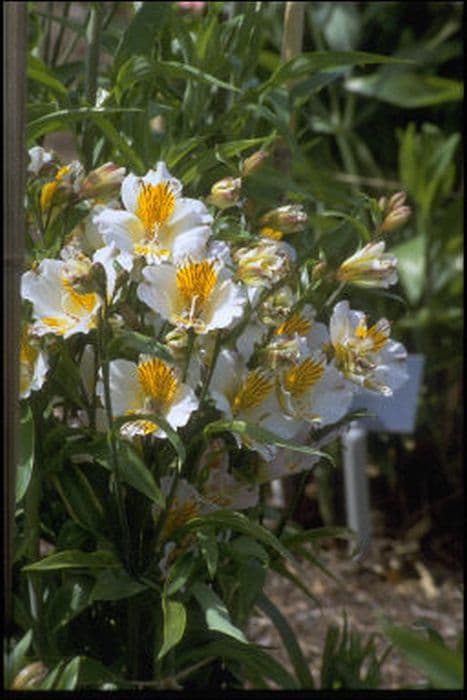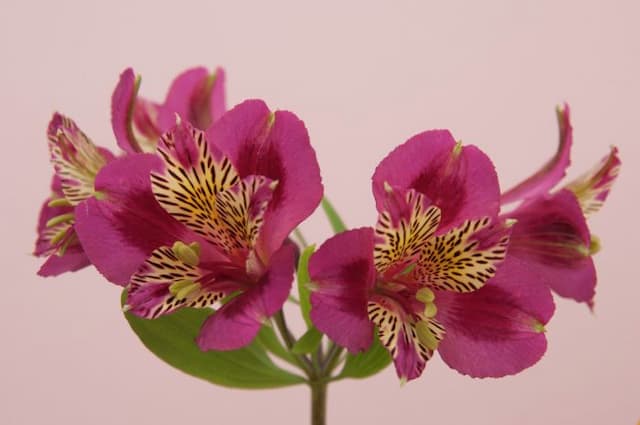Peruvian Lily Alstroemeria Princess Lilian = 'Zaprilian' (PBR) (Princess Series)
![Peruvian lily [Princess Lilian]](/_next/image?url=https%3A%2F%2Fplants-admin.emdemapps.com%2Fimages%2Fplants%2F%2Fimages%2F604b579d859b6.png&w=3840&q=75)
ABOUT
Alstroemeria Princess Lilian, also known as Peruvian Lily from the Princess Series, is a striking plant that produces an abundance of flowers. Each blossom exhibits a stunning combination of colors, often featuring shades of pink and cream with highlights of dark burgundy whisker-like markings that streak from the throat of the petals. The petals are slightly ruffled and recurved, adding a touch of elegance to the overall appearance. The foliage of the Peruvian Lily is lance-shaped and a vibrant green, which forms a lush backdrop for the vivid flowers. The leaves can also be interesting as they have a tendency to twist so that the bottom surface is facing upwards. In bloom, the plant becomes a hub of activity, attracting pollinators such as bees and hummingbirds. The arrangement of the flowers and the foliage often gives the plant a bushy and full look, making it a popular choice for gardeners seeking to add vibrant color and texture to their garden.
About this plant
 Names
NamesFamily
Alstroemeriaceae
Synonyms
There are no specific common names associated with Alstroemeria Princess Lilian = 'Zaprilian' (PBR) (Princess Series) beyond its general common names such as Peruvian Lily, Lily of the Incas.
Common names
Alstroemeria 'Zaprilian'
 Toxicity
ToxicityTo humans
Alstroemeria, commonly known as Peruvian lily or lily of the Incas, is not considered highly toxic to humans. However, it can cause mild irritation if ingested or if the sap comes into contact with skin. If ingested, it may result in nausea, vomiting, or diarrhea. Handling the plant might cause skin irritation or allergic reactions in some individuals.
To pets
Alstroemeria, commonly known as Peruvian lily or lily of the Incas, can be mildly toxic to pets if ingested. It may cause gastrointestinal upset, such as vomiting or diarrhea. Cats and dogs might also experience mild drooling or show signs of nausea. It's recommended to keep this plant out of reach of pets to avoid these potential symptoms.
 Characteristics
CharacteristicsLife cycle
Perennials
Foliage type
Evergreen
Color of leaves
Green
Flower color
Mixed
Height
1 foot 8 inches (50 cm)
Spread
1 foot (30 cm)
Plant type
Herb
Hardiness zones
8
Native area
South America
Benefits
 General Benefits
General Benefits- Long Blooming Season: Alstroemeria Princess Lilian produces flowers for an extended period, typically from late spring to early fall, offering long-lasting color in the garden.
- Vibrant Colors: The plant features eye-catching, bicolored flowers in shades of pink and orange, adding vibrancy to landscaping and floral arrangements.
- Attracts Pollinators: With its colorful flowers, Alstroemeria Princess Lilian attracts bees, butterflies, and other pollinators, contributing to the health of the local ecosystem.
- Low Maintenance: This variety is comparatively easy to care for, requiring minimal upkeep once established, which is ideal for gardeners of all skill levels.
- Drought Tolerance: Once established, Alstroemeria Princess Lilian is quite tolerant of dry conditions, making it suitable for water-wise gardens.
- Excellent Cut Flowers: The stems of this plant are sturdy and long-lasting when cut, making them perfect for use in floral arrangements and bouquets.
- Cold Hardy: This plant is relatively resistant to cold temperatures, which allows it to perform well in climates with cooler winters without much additional protection.
- Compact Growth: The Princess Series, including Alstroemeria Princess Lilian, is known for its compact growth habit, making it well-suited for both garden beds and container gardening.
- Multiplication: Alstroemeria Princess Lilian can reproduce through tuberous roots, which can be divided to propagate new plants and expand the garden display.
- Non-Invasive: Unlike some other species of Alstroemeria, the Princess Series cultivars tend to be less aggressive spreaders, making garden management easier.
 Medical Properties
Medical PropertiesThis plant is not used for medical purposes.
 Air-purifying Qualities
Air-purifying QualitiesThis plant is not specifically known for air purifying qualities.
 Other Uses
Other Uses- Photography Enhancement: Alstroemeria is often used as a subject for macro and nature photographers due to its intricate patterns and vivid colors, helping to create stunning visual content.
- Edible Decor: While not commonly known for edibility, the petals of Alstroemeria can be used to garnish salads or desserts, adding a unique flair to culinary presentations (it's important to verify they are free of pesticides and are indeed edible).
- Eco-friendly Wrapping: The large leaves of Alstroemeria can be used as a natural and biodegradable wrapping for small gifts, enhancing the sustainability of gift-giving.
- Art Inspiration: Artists can use the complex colors and forms of Alstroemeria as inspiration for paintings, drawings, and textile designs, reflecting the plant's natural beauty.
- Natural Dyes: The pigments in Alstroemeria petals could be used to create natural dyes for fabrics, though this is a less conventional use for the plant.
- Bookmark Crafting: Dried Alstroemeria flowers can be laminated to create artistic and durable bookmarks for book lovers.
- Theme Gardens: Due to their bright colors, Alstroemeria can also be used to create a royalty-themed garden, pairing well with other plants in the Princess Series.
- Creative Writing Prompt: The striking appearance of Alstroemeria might inspire writers to include detailed descriptions of flora in their stories or poems.
- Teaching Tool: Alstroemeria can be used in botany education to demonstrate the characteristics of monocot plants, including flower symmetry and leaf arrangement.
- Floral Crafts: Dried Alstroemeria flowers can be incorporated into homemade potpourri mixes, adding fragrance and color.
Interesting Facts
 Feng Shui
Feng ShuiThe Alstroemeria, commonly known as the Peruvian Lily, is not traditionally used in Feng Shui practice.
 Zodiac Sign Compitability
Zodiac Sign CompitabilityThe Peruvian Lily is not used in astrology practice.
 Plant Symbolism
Plant Symbolism- Friendship: Alstroemeria, commonly known as Peruvian Lily or Lily of the Incas, typically represents enduring friendships due to its twisted leaves which are said to symbolize the trials and tribulations that friendships endure over time.
- Devotion: The multiple flowers on each stem of the Peruvian Lily suggest a strong bond and mutual support, symbolizing devotion between individuals.
- Wealth and Prosperity: With its lush blooms and long-lasting nature, Peruvian Lilies are often associated with wealth and the abundance of prosperity.
- Fortune: The vibrant colors and eye-catching patterns of the Peruvian Lily symbolize good fortune and are often given to wish someone success and happiness.
- Achievement: Given as a gift, the Peruvian Lily encourages the receiver to keep striving forward, representing the achievement of personal aspirations and goals.
 Water
WaterPeruvian lilies, like the Alstroemeria Princess Lilian, should be watered regularly to keep the soil consistently moist but not waterlogged. During the growing season, watering once a week with approximately 1 to 2 gallons per square foot is ideal, depending on weather conditions. Adjust the amount of water during extreme heat or drought to ensure the soil doesn't dry out. In winter, reduce watering frequency to match the plant’s reduced growth and evaporation rates. Always check the top inch of soil for dryness before watering to avoid overwatering.
 Light
LightPeruvian lilies thrive in bright, indirect sunlight. The best spot for Alstroemeria Princess Lilian is a location where it can receive morning sun and partial shade during the intense heat of the afternoon. Direct sunlight can scorch the leaves, so ensure it's protected during the peak hours of sunlight.
 Temperature
TemperaturePeruvian lilies prefer temperatures between 65 and 75°F and can survive minimum temperatures down to 25°F. Alstroemeria Princess Lilian performs best in this range but should be protected from frost to prevent damage. It should also be sheltered from extreme heat above 90°F as that may stress the plant.
 Pruning
PruningPruning Peruvian lilies encourages healthy growth and stimulates blooming. For Alstroemeria Princess Lilian, pruning should be done by gently pulling the spent stems from the base to promote new growth. This can be done throughout the blooming season. A thorough pruning should be done in late fall or early winter, after flowering has ceased, to keep the plant tidy and remove dead foliage.
 Cleaning
CleaningAs needed
 Soil
SoilPrincess Lily prefers well-draining soil with high organic matter. The best soil mix is a blend of two parts peat or coco coir, one part perlite or sand, and one part compost or aged manure. Aim for a slightly acidic to neutral pH between 6.5 and 7.
 Repotting
RepottingPrincess Lilies should be repotted every 2 to 3 years to replenish soil nutrients and accommodate root growth. Spring is the ideal season for repotting when the plant is actively growing.
 Humidity & Misting
Humidity & MistingPrincess Lilies thrive in moderate to high humidity levels, preferably between 40-60%. Consistently high humidity supports their lush growth and vibrant blooms.
 Suitable locations
Suitable locationsIndoor
Place in bright, indirect light and keep moist.
Outdoor
Plant in sun or part-shade; shelter from strong winds.
Hardiness zone
7-10 USDA
 Life cycle
Life cycleAlstroemeria, also known as Peruvian Lily or Lily of the Incas, typically begins its life cycle as a tuber or rhizome planted in early spring. The plant then germinates and sprouts stems and leaves as temperatures rise. The growing foliage develops into a bushy plant, and flower buds form as the plant matures. Flowering generally occurs in early summer and can continue throughout the growing season with proper care and deadheading. After the blooming period, if the flowers aren't deadheaded, they may produce capsule-like fruits with seeds, although Alstroemeria are more commonly propagated vegetatively. As temperatures drop in late autumn, the plant's above-ground growth dies back, with the tubers remaining dormant underground during the winter ready to restart the cycle come next spring.
 Propogation
PropogationPropogation time
Spring to Summer
One of the most popular methods of propagating Alstroemeria 'Princess Lilian' is through division of its rhizomes. This is usually performed in the spring as new growth appears. Begin by carefully digging up the clump of the plant, ensuring you keep a generous amount of soil around the roots. Gently tease apart the rhizomes, each with a section of roots and shoots, to create new plants. Replant the divisions immediately at the same depth they were previously growing, spacing them approximately 12 to 18 inches (30 to 45 centimeters) apart to allow for mature growth. Water the new plants well to settle the soil around the roots and to help reduce transplant shock. Division helps to rejuvenate older clumps that may have become too dense, promoting better blooming and overall health of the plant.





![Peruvian lily [H.R.H. Princess Alice]](/_next/image?url=https%3A%2F%2Fplants-admin.emdemapps.com%2Fimages%2Fplants%2F%2Fimages%2F604b55e81c8b0.png&w=640&q=75)

![Peruvian lily [Inca Coral]](/_next/image?url=https%3A%2F%2Fplants-admin.emdemapps.com%2Fimages%2Fplants%2F%2Fimages%2F604b5b79b85ce.png&w=640&q=75)
![Peruvian lily [Inca Exotica]](/_next/image?url=https%3A%2F%2Fplants-admin.emdemapps.com%2Fimages%2Fplants%2F%2Fimages%2F604b5ec0e34a9.png&w=640&q=75)
![Peruvian lily [Inca Milk]](/_next/image?url=https%3A%2F%2Fplants-admin.emdemapps.com%2Fimages%2Fplants%2F%2Fimages%2F604b5f14b0b6a.png&w=640&q=75)